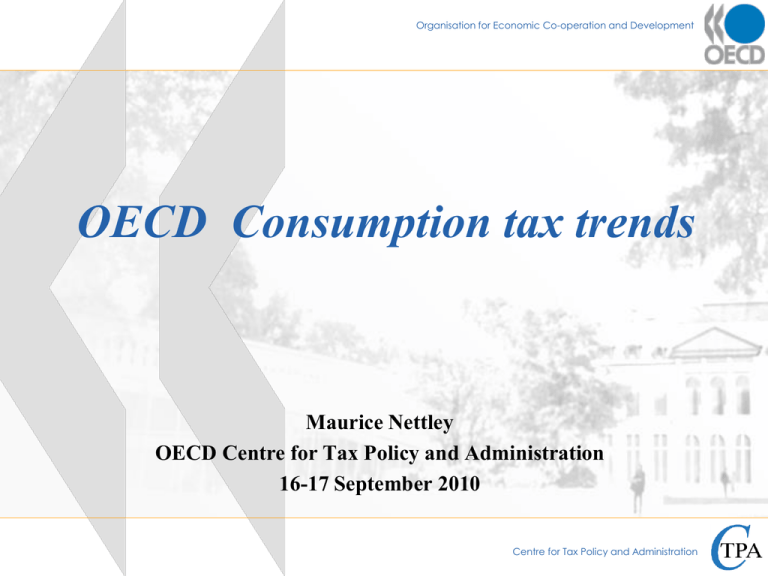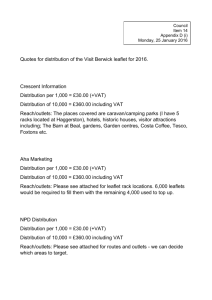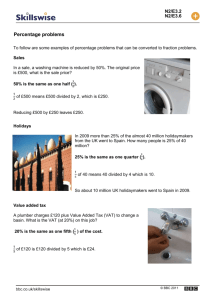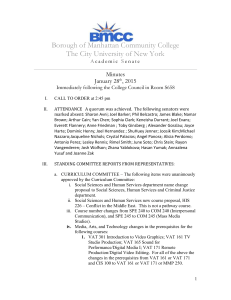Consumption taxes General consumption taxes
advertisement

Organisation for Economic Co-operation and Development OECD Consumption tax trends Maurice Nettley OECD Centre for Tax Policy and Administration 16-17 September 2010 Centre for Tax Policy and Administration Consumption taxes General consumption taxes - Value added taxes (VAT) and its equivalent in several jurisdictions, the Goods and Services tax (GST) - Sales taxes Taxes on specific goods and services - Excise taxes levied on specific goods - Motor vehicle taxes - Custom duties and other taxes on insurance or financial operations 2 Overview of contents Discussion of topical issues relating to consumption taxes Reports on consumption tax yields in the OECD area 3 - trends in tax to GDP ratios - trends in share of total tax ratios Rates and structure of VAT in the OECD area Some details of structure and tax rates for selected excise duties in OECD Taxation of motor vehicles Topical issues relating to consumption taxes Examples in the 2008 and 2010 publications relating to developments in the cross-border trade area 4 The path from the 1998 Ottawa Taxation Framework Conditions to the draft International VAT/GST guidelines Need to avoid double taxation or double non-taxation Draft VAT/GST guidelines released on the OECD website - Definition of the place of taxation for business to business internationally traded services and intangibles - This is a living document to be expanded in the future Reports on consumption tax yields (1) 5 On average the breakdown of tax revenues in the OECD area in 2007 was as follows: - Personal income tax 25% - Corporate income tax 11% - Social security contributions 25% - Payroll taxes 1% - Property taxes 6% - General consumption taxes 19%)) 30% - Specific consumption taxes 11%)) - Other taxes 3% TOTAL 100% Reports on consumption tax yields ( 2 ) Trends in share of total taxation - 1965 to 2007 Consumption taxes total - Fell from 36 to 30% General consumption taxes - Rose from 12 to 19% Specific consumption taxes - Fell from 24 to 11% Trends in tax to GDP ratios - 1965 to 2007 Consumption taxes total - Rose from 9.1 to 10.3% General consumption taxes - Rose from 3.3 to 6.7% Specific consumption taxes - Fell from 5.8 to 3.5% 6 Rates and structure of VAT in the OECD area (1) 7 Evolution of VAT/GST rates in the OECD area over the past 30 years Details of the use of lower rates, domestic zero rates and exemptions for specific goods and services Details of annual turnover concessions for VAT/GST registration and collection Existence of special VAT/GST taxation methods such as the use of the reverse charge scheme or margin schemes Rates and structure of VAT in the OECD area (2) 8 Calculation of the VAT Revenue Ratios in OECD member countries The VAT Revenue Ratio equals (VAT revenue)/ ([consumption – VAT revenue] * standard VAT rate) Defined as the ratio between the actual VAT revenue collected and the revenue that would be collected if VAT was applied at the standard rate to all final consumption Parameters of a selected range of excise taxes in OECD member countries (1) Details of tax rates and structure of the tax regimes for Taxation of beer, wine and other alcoholic beverages Tobacco products – cigarettes, cigars, cigarette rolling tobacco, pipe tobacco Mineral oil products – leaded/unleaded petrol, diesel oil, heating oil and heavy fuel oil 9 Taxation of motor vehicles 10 Taxes on sale and registration of motor vehicles ( defined in most cases as a registration tax ) Periodic taxes in connection with the ownership of a vehicle ( defined in most cases as a circulation tax ) Taxes on fuel Any other taxes and charges , such as insurance taxes and road tolls etc Why is this an important publication? 11 A unique source of both information and internationally comparable data on consumption taxes – unique in terms of the range of countries covered. Provides analyses of trends in tax yields. Monitors the evolution of tax rates and the structure of consumption taxes. It is an excellent tool for individual countries to assess their position relative to other countries on criteria such as VAT rates, registration thresholds, scope for exemptions and reduced rates. The VAT Revenue Ratio enables a view of the different countries’ capacity to capture the potential tax base. 12 Thank you and any questions?








